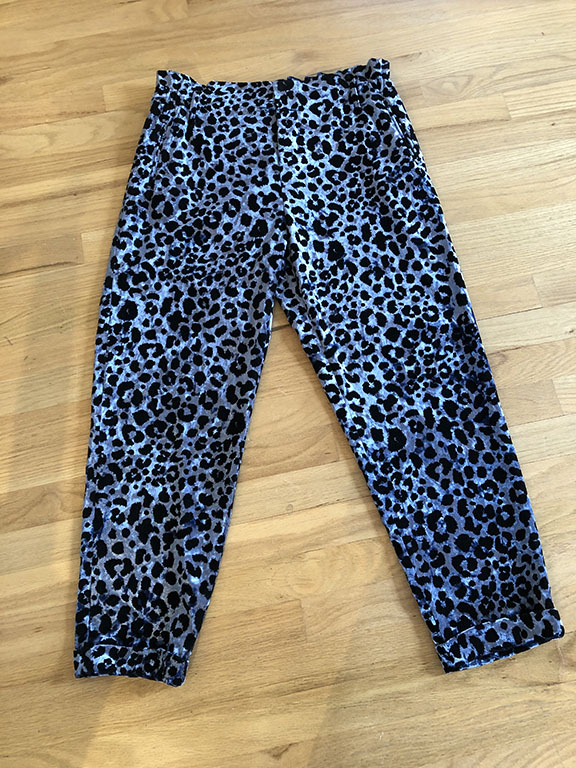Snakeskin-patterned bags are a hot item this fall.
Photo courtesy Lotus Way
Your closet might be looking like a zoo pretty soon and not because of clutter.
A style as on-again-off-again as Rachel and Ross in “Friends,” animal print has made a comeback with leopard and snakeskin prints at the forefront this year. Whatever your ideal style is, there’s an animal print piece for you.
If you’re looking to spice up your wardrobe with a pop of color, local shops including Lotus Way in Fair Haven can help. Owner Kathy Goullet said the store currently sells velvet blue and black leopard print pants that have been popular. The pants could pair well with a black top and fun blue earrings for a creative turn. “People like fun things,” Goullet said.
Lotus Way also sells classic animal print pieces, including Kinross reversible leopard print sweaters in sterling and taupe; snakeskin-patterned sweaters in tan and black from Repeat Cashmere; snakeskin bags; and dresses with enlarged tan and black camel spots and black faux fur trim from Tyler Boe.

Goullet said she has seen the animal print trend come and go through the years, but that there has been a real focus on it in 2019. The average shopper at Lotus Way is 40 and over, she said, but animal print can be popular for any age.
Marylouise Van der Wilden, owner of Le Papillon in Rumson, can attest to that. The boutique currently sells several classic animal print pieces that shoppers of all ages have been picking off the shelves. This includes blouses, suede pants, handbags, shoes and scarves in animal print patterns, mostly leopard.
“They’re more accent pieces than anything,” said Van der Wilden, like a leopard print scarf with a black top, or leopard print pants with a black shirt. The most popular piece available seems to be the suede leopard pants, she said. “It’s very soft and it’s not too loud. It’s more subtle.”
Big-name fashion brands such as Gucci, Versace, Paco Rabanne, Saint Laurent and more led the animal print trend in their collections presented earlier this year. Some even mixed and matched prints in layers, including in the Paco Rabanne Fall 2019 Ready-to-Wear Collection where one model strutted the runway in a leopard print jacket on top of a red snakeskin jacket, topped off with white and black snakeskin shoes. Another model was dressed in a leopard print blazer with snakeskin heels.
“Animal print is a classic,” said Tamara Lynas, creative director at Theo in Red Bank. “This season it’s extreme and people are mixing and matching animal print.”
Theo currently carries animal print scarves, sweaters, coats, dresses, blouses and handbags – “just about every item you can imagine,” she said. Prints are mostly snakeskin and python as well as leopard and cheetah. There are funky, bright animal prints available as well as classic natural tones.
And the trend seems to be continuing. The Victor Glemaud Resort 2020 Collection featured a model in a green zebra patterned shirt and yellow zebra pants.
Although types and styles of animal print clothing have varied through the years, the concept itself is not new. The trend was popular in the 18th century, according to L’Officiel, a French fashion magazine, and was worn to show off the status of power and wealth. It gained popularity in the United States in the 1960s and increased through the ’70s and ’80s as the desire for bolder style grew.
And it has been traced back even further. According to CNN, pictures of Seshat, the Egyptian goddess of wisdom, show her in leopard or cheetah hide. Additionally, a clay figure in the “Seated Woman of Çatalhöyük” created around 6000 B.C. shows a woman resting her arm on a leopard.
In 1947, Christian Dior was credited as the first designer to put leopard print, not fur, on the runway, according to CNN. It was popular among style icons including Josephine Baker, Jackie Kennedy and Elizabeth Taylor.
Now the question becomes, will it ever go out of style? Will style icons dress in leopard print and snakeskin patterns into the 22nd century?
Just remember, what you buy today might be useful five, 10, even 20 years from now, showing us that sometimes it does, in fact, pay to keep those zoo prints in the closet.














